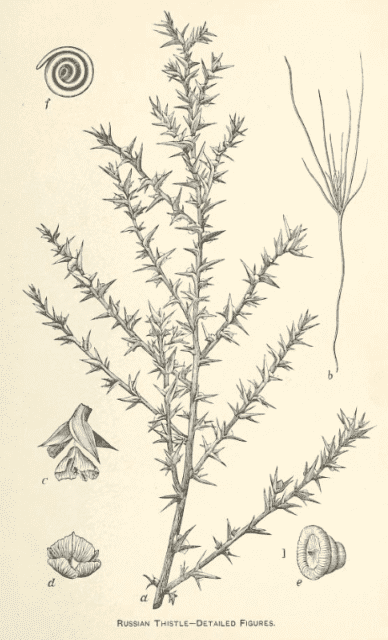The Russian Biological warfare on US soil can be dated back to as early as 1873. The warfare was not started intentionally but has now reached epic proportions. If you have read the news lately about happenings in Eagle Mountain you will have noticed the effects of this war that has been happening since 1873. According to a report by the US Government printing office in 1894, this biological agent has three distinct methods of dispersal. Two of which are currently still problems in Eagle Mountain one was eliminated in 1913. The agent travels easily by wind as well as piggybacks with the transportation of seeds. In 1913 the railroad left Eagle Mountain eliminating one of the methods of dispersing. Leaving Eagle Mountain with two common dispersal methods. Eagle Mountain has plenty of wind as well as imported seeds that are used for animal feed and agricultural purposes in the Cedar Valley.
This biological entity has the Scientific Name Salsola Icali tragus. After its introduction to the small town of Scotland, Bonhomme County, South Dakota. It now has spread to every corner of the United States, except for Florida and Alaska. Salsola L. is the genus that has been created for this biological nuisance. Most people know it as the “Tumbleweed”, or as its other name the Russian Thistle. According to the 1894 report published by the US Government titled, “The Russian Thistle: Its History as a Weed in The United States, with an Account of the Means Available for its Eradication.” it all started from a shipment of Rye from Russia that was planted by a farmer in Scotland South Dakota. The weeds continued to spread until they have become a curse to farmers and homeowners in almost every state in the United States. Utah is one of the hardest hit. New Mexico is also a hard-hit state. New Mexico had a tumbleweed problem hit them in December of 2021. During a major windstorm, millions of tumbleweeds closed sections of the freeway as well as buried houses. But they are not new to the problems of tumbleweeds. Back in 2014 the small town of Roswell, New Mexico was buried in tumbleweeds.
Utah has the ideal environment for the tumbleweed or Russian Thistle to thrive. And when you add the high winds of Eagle Mountain into the mix the single tumbleweed has no problem spreading it’s up to 200,000 seeds across large open fields in Eagle Mountain.
The tumbleweed by design only has a shallow root system. After it has reached its maturity, it flowers, creates seeds, and then dies. It is held to the ground by a single stem, that then breaks and allows the weed to tumble freely dropping its seeds as it rolls around the foothills of Eagle Mountain.
The 1894 report talks about its introduction to the US. “The plant was first introduced into the United States in 1873 or 1874 in flaxseed brought from Russia and sown near Scotland, Bonhomme County, S. Dak. The land there is somewhat hilly, and corn is the chief crop raised, so that, owing to the wooded ravines and the standing cornstalks, the Russian thistle was at first slow in spreading. In 1877 it first appeared in Yankton County, east of Bonhomme, and five years later it had spread to the counties to the north and west of Bonhomme. It continued gradually to cover new territory until 1888 when it had infested most of the counties between the Missouri and James rivers south of the Huron, Pierre, and Deadwood Division of the Chicago and Northwestern Railway. The strong winds during the winter of 1887-’88, followed by the dry summer of 1888, and possibly a fresh importation of seed into the flax fields of Faulk or McPherson counties, caused the weed to spread within two years to nearly all the remaining counties between the Missouri and James rivers in South Dakota and to infest the southern tier of counties in North Dakota. At about the same time it invaded northern Iowa and northeastern Nebraska. The dates on map 2 indicate approximately the years during which the Russian thistle first appeared in the counties thus marked.”

The Utah State University Extension has this to say about the Russian Thistle.
When Russian thistle is mature, it pulls free of the soil and blows away, hence the name “tumbleweed.” This is how the seed is spread.
Young shoots of Russian thistle can be used as a potherb and seeds can be ground into meal. It is sometimes used for Christmas decoration.
Russian thistle is sometimes harvested for hay and silage. Russian thistle hay is credited with saving the beef cattle industry in Canada and the United States during the Dust Bowl era, when conventional hay crops failed and no other feed was available for starving animals.”
https://extension.usu.edu/rangeplants/forbsherbaceous/RussianThistle
I believe this is the only place I have seen a praiseworthy reason for the Russian Thistle. The Russian Thistle “is credited with saving the beef cattle industry of Canada and the United States during the Dust Bowl era…”
The common migration of the Russian Thistle has been a topic of conversation on many Eagle Mountain-related social media posts. I thought it would be interesting to know exactly where the Russian Thistle or Tumbleweed originated and how big of a problem it is now.
The 1894 report gives us the ONLY way to radicate this weed from the US. The problem is, that we are now in the year 2022 and the problem is still plaguing us. “For any effective measures, however, the two following principles must be rigidly adhered to :
- The Russian thistle should be allowed to produce seed.
- There must be concerted action throughout all the infested areas.
If the Russian thistles, wherever found, should be killed before they produce seed, during three successive years, the pest would in all probability be completely exterminated. If the plants are destroyed over local areas, even throughout townships, counties, or entire States, and allowed to grow beyond the boundary lines, comparatively little advantage will be gained, for the rolling tumbleweeds will soon reseed the area cleared.”

The War Continues Today
The US has declared war on this weed of Russian origin. Because Russian Thistle is known to be herbicide-resistant, they have started looking into other ways and options for eradication.
- “In early October 2005, dying tumbleweed plants were found along the Aegean Sea at Kryopigi Beach, Greece. All plants in the area were diseased and about 80% were dead or dying. Diseased stem pieces were taken to the European Biological Control Laboratory, USDA, ARS, at American Farm School in Thessaloniki, Greece.”
- “In September of 2007, dying tumbleweed plants were found along the Azov Sea at Chushka, Russia. All of the plants in the area were diseased and about half of these were dead or dying. Diseased stem pieces were taken to the All Russian Research Institute of Phytopathology, Moscow, Russia. There, a fungus with characters conforming to the description of a Phomopsis species was isolated from the diseased stems. Pure cultures from these isolations were sent to the quarantine facility of the Foreign Disease-Weed Science Research Unit, USDA, ARS, Fort Detrick, MD for testing.”
- “A 2-yr study conducted in the low-rainfall zone compared postharvest Russian thistle control; amount of herbicides used, and associated costs with a conventional broadcast sprayer and a light-activated, sensor-controlled sprayer. Russian thistle control was similar within each of two herbicide treatments regardless of sprayer with the best herbicide treatment controlling Russian thistle > 90%. Impact: The light-activated, sensor-controlled sprayer reduced the amount of herbicides used by an average of 42% and reduced herbicide cost of the most effective treatment up to $7.37/a compared to the conventional broadcast sprayer. The use of the light-activated, sensor-controlled applicator will provide excellent postharvest Russian thistle control while increasing farm profitability and environmental quality.”
- “Two species of insect biological control agents have been introduced but they have not significantly controlled the weed. The mite, Aceria salsolae, was discovered in 1996, and has been evaluated as a prospective biological control agent. Quarantine laboratory studies determined that the mite has a very narrow host plant specificity. The mite poses negligible risk to nontarget plant species, and it has the potential to significantly reduce Russian thistle. The mite has been recommended for release as a biological control agent by the USDA-APHIS Technical Advisory Group (TAG).”
- “Even though the plants look the same, there are now two different kinds (called “Types” A and B) of Russian thistle in the United States. This is important, because they may also differ biologically. If so, then different ways might be needed to control them. In this study, we learned that the two Types are different, and that one is infected and damaged by two different disease agents (pathogens) and the other isn’t. If these pathogens were to be used for biological control, then not all of the Russian thistles in the United States would get sick. The others would stay alive and continue to be pests. We now know that it will be necessary to get something else to kill or damage the other Type.”
Most Cedar Valley residents do not have access to the biological agents suggested by the government above. But we can continue to fight this aggression with fire, shovels, and pitchforks.
Mike Kieffer – Editor-in-Chief, Cedar Valley Sentinel
Mike Kieffer is a dynamic leader and community advocate based in Eagle Mountain, Utah. He serves as the Editor-in-Chief of the Cedar Valley Sentinel, a local publication dedicated to informing, inspiring, and elevating the Cedar Valley community through honest and accurate journalism. With a passion for fostering connections, Kieffer has made it his mission to highlight local businesses, provide reliable news, and support community development.
Beyond his editorial role, Kieffer is the owner of Lake Mountain Media, LLC, a company specializing in media and communications, and the co-owner of Quail Run Farms, which focuses on sustainable farming and community engagement. He also actively contributes to the local economy and culture as a member of the Eagle Mountain Chamber of Commerce.
Kieffer’s dedication extends to preserving and promoting the history and heritage of the Cedar Valley area. He often participates in community-centered events and media, including podcasts that explore the unique aspects of life in the region. Through his varied endeavors, he remains a steadfast advocate for the growth and enrichment of the local community.


